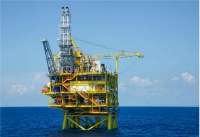OIL PRICE - LONDON. Oil prices fell on Monday, hit by a stronger dollar and investor concerns over the possibility of quicker than expected increases to interest rates by the U.S. Federal Reserve.
Brent crude fell 65 cents, or 0.7%, to $87.24 a barrel by 1335 GMT. U.S. West Texas Intermediate (WTI) crude dropped 84 cents, or 1%, to $84.30.
The dollar rose to a two-week high on Monday against a basket of currencies, lifted by the tension between Russia and the West over Ukraine and the possibility of a more hawkish stance from the Fed this week.
Brent had risen more than a $1 earlier in the session on concerns over tight supplies and elevated geopolitical risks in Europe and Middle East.
Further escalation of the situation in both Ukraine and the Middle East "justify a risk premium on the oil price because the countries involved – Russia and the UAE – are important members of OPEC+", said Commerzbank analyst Carsten Fritsch.
Read Also: Oil Falls as Investors Scoop Up Profits After U.S. Inventory Build
Tensions in Ukraine have been increasing for months after the Kremlin massed troops near its borders, fuelling fears of supply disruption in Eastern Europe.
The U.S. State Department announced on Sunday that it was ordering diplomats' family members to leave Ukraine.
Energy markets are likely to be hit if tensions turn into conflict. Europe relies on Russia for about 35% of its natural gas. JPMorgan said the tensions could prompt a "material spike" in oil prices.
However, Russia said on Monday that it remained a reliable energy supplier to Europe even at "uneasy periods in our relations".
In the Middle East, the United Arab Emirates intercepted and destroyed two Houthi ballistic missiles targeting the Gulf country on Monday after a deadly attack a week earlier.
Barclays, meanwhile, has raised its average oil price forecasts by $5 a barrel for this year, citing shrinking spare capacity and elevated geopolitical risks.
The bank raised its 2022 average price forecasts to $85 and $82 a barrel for Brent and WTI respectively.
Both benchmarks rose for a fifth week in a row last week, gaining about 2% to their highest since October 2014.
Oil prices are up more than 10% this year on the concerns over tightening supplies and OPEC+ now struggling to hit a targeted monthly output increase of 400,000 barrels per day (bpd).
Read Also: Oil Edges Higher on Tight Supply, Limited Omicron Impact
Saudi Aramco CEO Amin Al Nasser said that demand for oil is nearing pre-pandemic levels, Asharq Business reported on Monday.
Iraq has already scheduled some oil shipments for loading in March on projections of strong demand, according to Ali Nizar, deputy head of Iraq's State Organization for Marketing of Oil (SOMO). The market could need additional quantities of oil and OPEC+ will offer more to the market if needed, Nizar said.
/2021/11/04/1030399418p.jpg)









